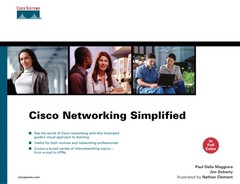IP multicast is a bandwidth-conserving technology based on the IP protocol in which a data intended for multiple receivers is efficiently transmitted with a single stream. IP multicast best serves streaming audio, video, and data applications such as software distribution or stock-quote broadcasts.
Take this example: A corporate officer needs to deliver a live video broadcast to the company’s employees. Doing so across an IP network using traditional IP protocols would require that the video feed be replicated once for every user. For a branch office across a wide-area network (WAN) link, 20 employees watching the video on their computers would result in the video stream being replicated 20 times across the WAN. The original data stream then must be replicated 20 times across the single WAN connection. Not only is this highly inefficient, but the WAN link would not be able to handle the sheer amount of traffic being transmitted.
IP multicast protocols allow users to request a particular multicast service (which can be audio, video, or data). The network then determines the source of the multicast transmission and routes the multicast stream to its destination. Multicast protocols ensure that only one copy of the stream is transmitted across any given link. Therefore, in the previous branch-office example, only one copy of the video broadcast would be transmitted over the WAN and then replicated to each user at the local-area network (LAN) level.
Multicasts relate to the concept of a group. The receivers who express an interest in receiving a particular data stream define the group. A receiver must join the group by using the Internet Group Management Protocol (IGMP), which requires that routers and switches must support IGMP to communicate with the receiver. Not until the receiver joins the group can she receive the data stream.
A multicast IP address identifies a group. The Internet Assigned Numbers Authority (IANA) assigns multicast IP addresses using the IP Class D address space 224.0.0.0–239.255.255.255.
The routers in a network are responsible for identifying the most efficient, shortest path from the multicast transmitter to its group of receivers. The Layer 2 LAN switches are responsible for receiving the singular transmission and replicating it to each of the registered receivers.
Of the multicast-related routing protocols, the primary protocol is Protocol Independent Multicast (PIM). The routers use the PIM protocol to make forwarding decisions. PIM determines the shortest path for each multicast group based on the IP routing protocol running on the router (such as Enhanced Interior Gateway Routing Protocol, EIGRP, or Open Shortest Path First, OSPF). Using Reverse Path Forwarding (RPF), routers use the existing unicast routing table to determine upstream and downstream neighbors and eliminate any loops.
PIM operates in three different modes: sparse, dense, and sparse-dense. The mode determines when the routers start forwarding packets to the group. Sparse mode employs a “pull” model, and dense uses a “push” model.
In sparse mode, packets are not transmitted through the network until a receiver specifically requests to join the group. In dense mode, packets are transmitted throughout the network without regard to registered users, and the network prunes transmission to parts of the networks where no receivers are registered. Sparse mode is more efficient in that traffic goes only where requested, whereas dense mode blasts everywhere initially. Sparse-dense mode is the third mode (developed by Cisco) in which the network intelligently determines which mode to use as opposed to configuring just one or the other.
Sparse mode is generally implemented for standard video and audio transmission in corporate networks. A core component of a sparse implementation is the rendezvous point (RP). The RP is the central clearinghouse for multicast transmitters and group receivers. Multicast transmitters register themselves with the RP, and the network forwards requests from group receivers to the RP. The RP then facilitates the transmission of the data stream to the receivers.
If the RP fails or disappears from the network, receivers cannot register with senders. Therefore, a network needs multiple RPs. Anycast-RP is a protocol based on the Multicast Source Discovery Protocol (MSDP) that facilitates the fault-tolerant implementation of multiple RPs.
Dense mode floods traffic to every corner of the network. This brute-force method only makes sense when there are receivers on every subnet in a network. After traffic begins flowing, routers then stop the flow of (or prune) traffic to subnets that have no receivers. Companies generally do not implement dense mode except for special circumstances because of its fire-hose approach to data-stream replication.
Although PIM makes sense in a corporate network, it requires that a network be planned and configured to handle the particular implementation of PIM properly. This setup is not practical across the Internet and shared IP networks for which there is no guarantee that multicast is configured consistently or properly. Multiprotocol Border Gateway Protocol (MBGP) allows the scalable advertising and transmission of MBGP routes through the Internet.




